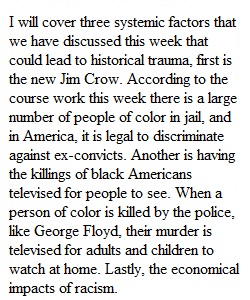


Q Class Discussion Historical Trauma We’ve covered a lot of material this week. The literature on race in America is enormous, multi-faceted, thoughtful and frequently brilliant. This week’s readings and course material barely scratch the surface. Nevertheless, we hope that it is clear that racism extends beyond individuals in time, space and the structure of government and laws. Please answer at least two of the questions below: Directions 1. We watched a video on historical trauma as part of the material on the historic development of racism in the United States. What are some of the systemic factors that we have discussed this week that could lead to historical trauma? What are some of the systemic factors that could maintain historical trauma? 2. When Michelle Alexander discusses mass incarceration as a new Jim Crow, she emphasizes the effects that linger long after prisoners are released. How might this influence the ability of individuals to form and maintain families? To maintain employment? To avoid future reincarceration? 3. Discuss some ways in which the racist social structures that we covered this week violate the principles of human rights that we discussed in Week 1. 4. In Week 6 we talked about increasing economic inequality in the United States. How might this economic inequality complicate activism aimed at closing economic and educational gaps between white Americans and Black, Latinx and Native Americans? 5. Black Lives Matter aims to improve the lives of Black Americans. Are there times when it makes sense for BLM to ally with folks who are not Black Americans in pursuit of common goals? Are there times when it doesn’t make sense to do so? 6. The map below shows a stretch of the East Side of Columbus, with a two square mile town called Bexley outlined in red. Bexley is a traditionally affluent and overwhelmingly white town that, among other things, includes the Ohio Governor’s mansion. It’s easy to notice that the two East/West highways in the map (I670 and I70) make sharp turns in order to avoid the town, cutting through neighborhoods that have a higher proportion of Black American residents. Apply our discussion of structural racism to this geography. As we said at the beginning of this discussion, we have barely scratched the surface of the literature on race and racism in America, so feel free to bring in other material that you might wish to reference. ________________________________________ Discussion Protocol: Your discussion response should fully address the discussion prompt and be supported by materials from the course and reading requirements. Additionally, your posts should be 2-3 paragraphs (approximately 250-300 words), be grammatically correct, and follow APA guidelines for references and style. Hidden Discussion:?You will not be able?to view other students posts until after you have posted your original response. Peer Exchange:?Please respond respectfully and thoroughly respond to at least two of your peers.
View Related Questions